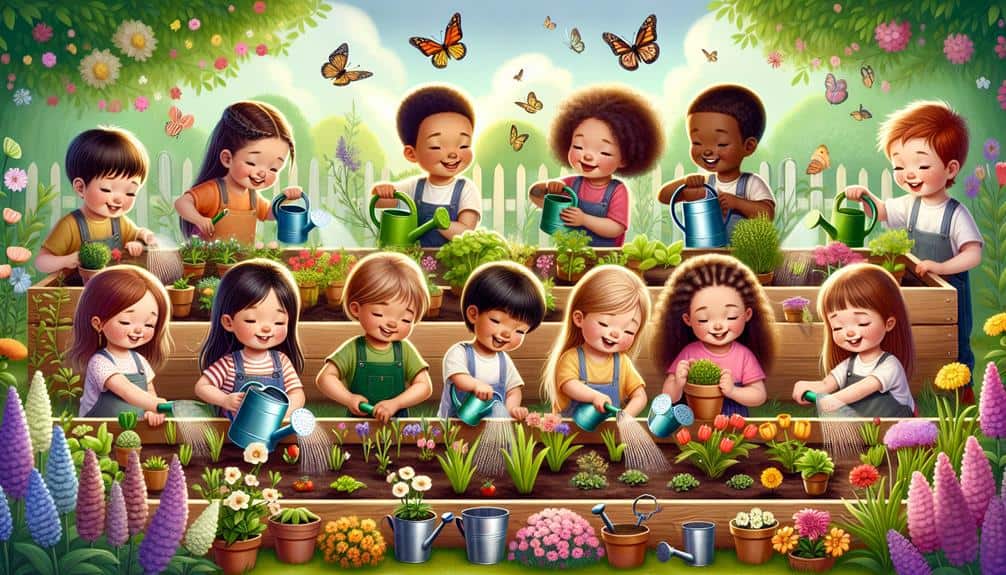Step into a vibrant world of outdoor homeschooling fun with educational gardening projects! Immerse yourself in the wonders of nature through hands-on experiences like observing plant life cycles and nurturing responsibility. Let the soil be your canvas, as you explore soil science experiments and investigate insects. Harvest your efforts and savor the joy of cooking with fresh produce. Infuse creativity into your curriculum with DIY garden markers and butterfly species identification. Explore the interconnectedness of nature as you engage in a range of enriching activities that blend learning with the beauty of the great outdoors.
Key Points
- Engage in hands-on planting activities to explore the plant life cycle.
- Create DIY garden markers using various materials for a fun and practical project.
- Conduct soil science experiments to understand soil composition and plant nutrients.
- Investigate and identify insects in the garden for a deeper connection to the natural world.
- Harvest produce for cooking activities to integrate culinary skills with gardening experiences.
Benefits of Gardening for Homeschooling
Discover the multitude of benefits that gardening can bring into your homeschooling curriculum, enhancing hands-on learning experiences and fostering a deeper connection to nature.
Nature journaling becomes an exciting adventure as you observe the growth and changes in your garden, noting down your observations and reflections.
Outdoor exploration takes on a whole new dimension as you dig in the soil, plant seeds, and witness the magic of new life sprouting forth.
Equipped with gardening tools like shovels, trowels, and watering cans, you learn valuable skills in caring for plants and cultivating the land. Understanding planting techniques such as proper spacing, soil preparation, and watering schedules becomes second nature as you immerse yourself in the world of gardening.
These practical skills not only benefit your garden but also translate into a deeper understanding of the natural world around you.
Through gardening, you not only nurture plants but also cultivate a sense of responsibility, patience, and appreciation for the environment. The hands-on experiences gained from tending to a garden will definitely enrich your homeschooling journey in ways that textbooks can't replicate.
Plant Life Cycle Exploration
Get ready to witness the magic of nature in action as you explore the intricate growth stages of plants.
From seed germination to flowering and fruiting, each phase offers a unique learning opportunity.
Engage in hands-on planting activities to truly understand and appreciate the beauty of the plant life cycle.
Growth Stages Overview
Explore the intricate phases of a plant's life cycle through a detailed overview of growth stages, offering a deeper understanding of the natural processes at play in educational gardening projects. As you investigate the growth stages of plants, you'll witness the marvels of nature unfold before your eyes.
- Seed Germination: Witness the magic of life as seeds sprout and begin their journey towards becoming mature plants.
- Root Growth: Explore beneath the surface and observe how roots develop and anchor the plant into the soil, providing essential nutrients and stability.
- Bloom Observation: Enjoy the beauty of flowers blooming, a dazzling display of colors and shapes that marks the reproductive phase of the plant.
- Fruit Development: Watch as flowers transform into fruits, showcasing the plant's successful reproduction and the formation of seeds for the next generation.
Hands-On Planting Activities
Begin a journey of exploration through engaging hands-on planting activities that explore the intricate stages of the plant life cycle, allowing you to witness nature's magic firsthand.
Seed germination, the first step in a plant's life, is a fascinating process where a tiny seed awakens and starts its growth journey. Experience this wonder by planting seeds in soil, providing water, warmth, and sunlight to observe the miracle of new life sprouting before your eyes.
Moving on to plant propagation, explore the art of creating new plants from existing ones. Take cuttings from a healthy plant, dip them in rooting hormone, and plant them in a suitable growing medium. Witness roots forming and new growth emerging, showcasing nature's resilience and vitality.
Through these activities, you not only learn about the plant life cycle but also develop a deeper appreciation for the interconnectedness of all living things. Get your hands dirty, nurture the growth, and revel in the beauty of nature's cycles right in your own backyard.
DIY Garden Markers Project
Enhance your garden's organization and aesthetics with a simple yet effective DIY garden markers project. Creating your own garden markers not only adds a personal touch but also helps you easily identify your plants.
To make durable and weather-resistant markers, consider using materials such as wooden spoons, rocks, wine corks, or even recycled plastic items. Get creative with your design to make them visually appealing and functional.
- Wooden Spoons: Paint or carve the names of your plants onto the handles for a rustic look.
- Rocks: Use weather-resistant paint to write plant names or create designs on smooth, flat rocks.
- Wine Corks: Attach a wooden skewer to the cork and write plant names on the cork's surface.
- Recycled Plastic Items: Cut up old plastic containers and write on them with permanent markers for a sustainable option.
Soil Science Experiments
Uncover the secrets hidden beneath the surface with engaging soil science experiments that will deepen your understanding of the earth beneath your feet.
Explore the fascinating world of soil composition through hands-on experiments that allow you to see, touch, and analyze the different components that make up the ground you walk on.
Investigate the intricate web of nutrient absorption by conducting experiments that demonstrate how plants take in essential minerals from the soil to thrive and grow.
Take your learning further by venturing into root system exploration activities that reveal the complex networks plants develop underground to support their growth and stability. By studying the way roots spread, branch out, and interact with the surrounding soil, you'll gain valuable insights into the crucial role these systems play in sustaining plant life.
Through these interactive experiments, you'll not only enhance your knowledge of soil science but also develop a deeper appreciation for the interconnectedness of the natural world around you.
Insect Investigation and Identification
Get ready to uncover the fascinating world of insects in your garden!
Utilize bug hunt techniques to observe these tiny creatures up close and personal.
Identify common garden pests that might be impacting your plants and learn to distinguish between different butterfly species fluttering around.
Bug Hunt Techniques
Explore the fascinating world of insect investigation and identification by learning effective bug hunt techniques.
When starting on bug hunts, it's crucial to equip yourself with the right tools and knowledge to make the most of your outdoor explorations. Here are some tips to enhance your bug hunting experience:
- Utilize a magnifying glass: Get up close and personal with the tiny world of insects by using a magnifying glass to examine their intricate details.
- Turn over rocks and logs: Many insects like to hide in dark, damp places. By carefully turning over rocks and logs, you may discover a whole new world of bugs.
- Use a butterfly net: Catching flying insects can be tricky, but a butterfly net can help you capture them gently for closer observation.
- Create a bug-friendly environment: Cultivate a garden that attracts insects by planting a variety of flowers and providing shelter like bushes and small trees.
Common Garden Pests
To truly understand and protect your garden, it's important to familiarize yourself with common garden pests through insect investigation and identification. By recognizing these pests early, you can implement effective pest control and prevention methods to safeguard your plants.
Some common garden pests include aphids, caterpillars, and spider mites, which can quickly damage your crops if left unchecked.
To combat these pests, consider utilizing natural solutions and garden-friendly predators. Ladybugs, lacewings, and praying mantises are beneficial insects that can help control pest populations in a sustainable manner.
Additionally, introducing plants like marigolds, lavender, and basil can act as natural repellents to deter unwanted pests from infesting your garden.
Butterfly Species Identification
In your quest for understanding the delicate world of butterflies, starting the journey of butterfly species identification will reveal a world of beauty and diversity waiting to be discovered.
When observing these majestic creatures, pay close attention to their wing patterns, as these can help you distinguish between different species.
Understanding the host plants that caterpillars feed on is essential in identifying specific butterflies, as they've unique preferences.
Explore the fascinating world of butterfly migration and learn about the incredible journeys these tiny insects undertake across vast distances.
Additionally, consider engaging in caterpillar rearing to witness the miraculous transformation from caterpillar to butterfly up close.
By immersing yourself in the intricate details of butterfly species identification, you'll gain a deeper appreciation for these enchanting creatures and the ecosystems they inhabit.
Embark on this enthralling exploration and discover the wonders of the butterfly world.
Harvest and Cooking Activities
Once your students have harvested their produce from the educational garden, encourage them to engage in hands-on cooking activities to fully appreciate the journey from seed to plate. Immerse yourselves in the world of seasonal recipes that highlight the fresh produce your garden has yielded. From vibrant salads bursting with color to hearty soups brimming with flavor, there are endless possibilities to explore.
Integrate cooking lessons into your homeschooling curriculum by involving your students in the entire process, from selecting the ripest vegetables to washing, chopping, and finally cooking them into delicious dishes. This hands-on experience not only enhances their culinary skills but also fosters a deeper connection to the food they eat.
To further extend the learning, consider incorporating garden crafts into the mix. Create beautiful table centerpieces using freshly picked flowers or design herb-infused oils and vinegars as gifts for loved ones. These activities not only stimulate creativity but also reinforce the importance of sustainable living and self-sufficiency.
Embrace the harvest season with open arms and savor the fruits of your labor in the most delightful way possible.
Frequently Asked Questions
Can Gardening Projects Be Adapted for Children With Special Needs?
Imagine walking through a vibrant sensory garden, where each plant tells a story through touch, smell, and color. By adapting tools and creating inclusive activities, gardening can offer therapeutic benefits for children with special needs.
How Can Gardening Activities Be Integrated Into Various Subjects?
To integrate gardening into subjects, conduct science experiments like soil pH testing. Calculate plant growth rates for math. Connect literature by reading garden-themed books. Teach history through the evolution of farming techniques. Engage all subjects in the garden!
Are There Any Safety Precautions to Consider for Homeschool Gardening?
Before diving into homeschool gardening, prioritize safety. Use proper tools safety measures and make sure sun protection. Did you know that 73% of gardening-related injuries involve hand tools? Stay safe while enjoying the outdoors!
What Are Some Budget-Friendly Gardening Project Ideas?
Looking for budget-friendly gardening projects? Get creative with DIY planters using recycled materials. Make seed bombs for guerrilla gardening. Engage in a garden scavenger hunt to learn about plants. Create nature art using leaves and flowers.
How Can Gardening Projects Promote Environmental Stewardship in Children?
You're in for a treat with nature exploration through gardening! By planting, nurturing, and observing plants, kids learn sustainability lessons firsthand. They grasp the importance of caring for the environment and appreciate nature's wonders.



